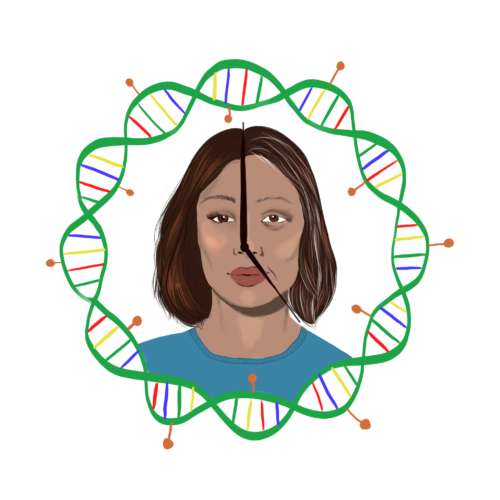Image Courtesy of Kara Tao.
Humanity has been obsessed with ending mortality for millennia. From famous historical conquests to find the Fountain of Youth to the contemporary race to find medicines combating heart disease, cancers, and neurodegeneration, scientists and philosophers alike are driven by the motivation to turn back the clock. Aging is a fundamental, natural process of life—all living organisms grow old and eventually die, and since the advent of molecular biology, scientists have attempted to figure out why.
Professor David Sinclair of Harvard University is a pioneer in the field of aging. From his discovery of the anti-aging molecule resveratrol to his successful restoration of eyesight for old and glaucomatous mice, Sinclair and his lab are making notable leaps in understanding and even reversing aging. One of the members of Sinclair’s team, postdoctoral fellow Jae-Hyun Yang, spearheaded an article published in Cell early this year studying one of the lab’s greatest contributions to the field of aging. They suggested that a loss of epigenetic information—changes in the chemical modification and packaging of our DNA and proteins within the nucleus—causes aging. Yang identified possible molecular mechanisms of aging and accordingly, a possible target for therapies that could one day reverse aging.
Prior to joining Sinclair’s lab, Yang was interested in studying epigenetic modifications that activated muscle genes during mouse embryonic cell differentiation, the process in which naive cells acquire a specific identity, as in whether they should be an eye cell, or a liver cell, or a muscle cell. Upon learning more about the fields of epigenetics and cell fate decision while obtaining his PhD, he was drawn to combining his interests and harnessing epigenetic mechanisms to study the process of aging. Differentiation is characterized by the accumulation of epigenetic information, while aging is characterized by the opposite. The team’s paper marks the success of a decade-long project to prove that loss of cell-specific epigenetic information contributes to aging.
“The difference between the epigenome and genome is similar to that of the software and hardware of a computer,” Yang said. Ultimately, the computer hardware—the amount of storage it has, its processing ability, its graphics elements—is similar to the genome of an organism: at its core, the organism is determined by the sequence of nucleotides in its DNA. However, the computer can’t actually do anything useful without software—applications that make the computer function the way it does. This is similar to the epigenome of an organism—by turning certain genes on and off at different points in their lifetime, epigenetic changes are capable of giving individual cells their identity, allowing them to become different types of cells.
When DNA is damaged, the process of preserving the lost genetic information causes the loss of the original epigenetic information. Yang hypothesized that the accumulation of this epigenetic information loss is what ultimately constitutes aging.
To test this hypothesis, Yang developed a genetically-altered mouse called ICE (Inducible
Changes to the Epigenome), to which epigenetic information loss could be introduced without genetic information loss. After inducing epigenetic information loss in ICE mice, Yang observed hallmarks of aging, including an increased frailty index (constituting body weight, grip strength, mobility, vision, and hearing), reduced bone density, damage to kidney cells, loss of melanocyte stem cells in skin contributing to fur graying, cognitive decline, and impaired muscle function. He found that many developmental processes that determine cell identity were altered in ICE-induced cells and mice. Regions of DNA that were far apart and originally should not have been able to impact each other did in fact bind and communicate, which caused cells to lose their identity. Specifically, he showed that muscle cells tended to behave more like immune cells after ICE treatment.
Next, Yang wanted to test if he could reverse the physiological effects he saw in his ICE mice. Knowing that gene-expression factors called the Yamanaka factors—Oct4, Sox2, Klf4, and Myc (OSKM)—alleviate the symptoms of aging mice, Yang wondered if treating his induced ICE mice with the Yamanaka factors, except Myc, would reverse features of aging. In fact, he found that treating cells or mice with OSK restored age-associated gene expression, epigenetic marks, and turned back the epigenetic aging clock. Yang hypothesized that there may actually be some copy of the epigenome in the cell that can be restored upon treatment with Yamanaka factors to reverse aging.
“It’s hard to target aging, as a treatment, because aging is not defined as a disease. But [Yamanaka factors] can be used for multiple different age-associated diseases. Currently, we can target different tissues and other projects in the lab are targeting eyes, muscles, and kidneys,” Yang said. “I hope we can eventually target aging as a whole, but for now we are targeting specific diseases and tissues. I’m interested in finding safer and cheaper methods that could replace [Yamanaka factors], so we can have the same effect without using gene therapy.”
Moving forward, Yang is interested in exploring some of the specific epigenetic factors that may be relocated after DNA damage, causing DNA cross-talk issues and contributing to epigenetic information loss. Yang is eager to find ways to make these proteins function more faithfully with the goal of preventing the aberrant cross-talk between far-apart DNA and the loss of cell specificity contributing to the progression of aging.
Yang and his fellow researchers in the Sinclair lab have their work cut out for them. From identifying single cell—as opposed to bulk tissue—epigenetic changes to testing the results of this paper on human cells, tissues, and organoids, their work aims to determine the most crucial factors contributing to the universal process of aging, enabling us to gain a deeper understanding of why, despite our differences, humanity is united in mortality. With their advancements directly contributing to possible treatments for all the diseases whose greatest risk factor is aging, we are inching closer than ever before toward a world in which we may indeed live longer and healthier lives.

